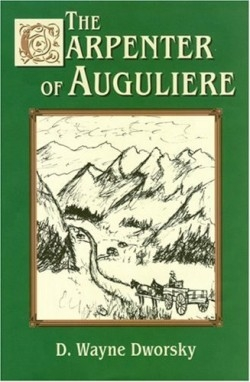It looks like you've stumbled upon a page meant to be read by our code instead of viewed directly. You're probably looking for this page.

The Carpenter of Auguliere
Here is an intriguing little book set in an unspecified era against the backdrop of a remote Eastern European village. With its slow but steady pace its good versus evil theme and its overall quirkiness think of The Carpenter of Auguliere by D. Wayne Dworsky as a cross between Clint Eastwood’s “The Good the Bad and The Ugly” and “Fiddler on the Roof.”
Stock one-dimensional characters populate this tender tale — the sneering villain replete with a long black cape; the sweet hand-wringing innocent with no rent money and a dying father; the gypsy crone who foretells the future in rhyme; and the quiet unassuming hero — a stranger who saunters into town and changes everything. The actions of these people are satisfying enough to create an interesting plotline but their inner motivations remain mysteries that are never solved. Reading about them is tantamount to experiencing a black-and-white film in slow motion; you know there’s meaningful content in there somewhere but it’s elusive.
Disparate components throughout the story also confound the reader — references to metals insects and tea leaves keep popping up but aside from their literal use their significance is never fully explained leaving the reader to wonder if he is missing some obscure literary allusion allegory or literary symbol that he is supposed to be “getting.”
Dworsky is a teacher as well as a published poet and one gets the idea that the well-traveled author a person who probably dabbles in entomology metallurgy and carpentry happened across an unusual locale that seized his imagination enough to pen an entire fiction around it.
Carpenter is not so much a novel but a kind of fable or moral tale with big cliqued themes like greed justice redemption and love. Yet it works well as entertaining reading and the author’s fine mind keeps you enthralled.
Readers of all ages will pick up this 153-page volume and read it straight through if for no other reason than to get a grasp on exactly where the author is going with all this. Yet unanswered questions prevail: Why have the heroine’s two sisters turned their backs on her and their father? Why would generation-after-generation of seemingly intelligent adults refuse to stand up to an unscrupulous landlord who rules their lives? And most of all what does metallurgy have to do with anything?
Reviewed by
Paige Henson
Disclosure: This article is not an endorsement, but a review. The publisher of this book provided free copies of the book and paid a small fee to have their book reviewed by a professional reviewer. Foreword Reviews and Clarion Reviews make no guarantee that the publisher will receive a positive review. Foreword Magazine, Inc. is disclosing this in accordance with the Federal Trade Commission’s 16 CFR, Part 255.